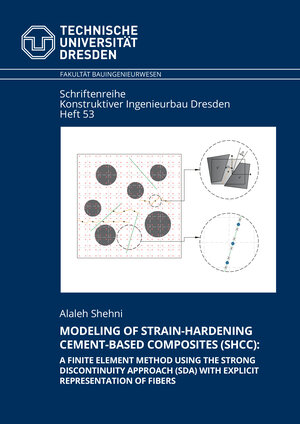
×
![Buchcover ISBN 9783867806565]()
Modeling of Strain-Hardening Cement-based Composites (SHCC)
A Finite Element Method using the Strong Discontinuity Approach (SDA) with Explicit Representation of Fibers
von Alaleh ShehniNowadays, the addition of a small volume of short fibers is a well-known strategy to increase the ductility and toughness of cementitious matrices besides optimization of the crack opening. Strain-hardening cement-based composites (SHCCs) is a particular class of fiber-reinforced concretes (FRCC) that can develop controlled multiple cracks while subjected to incremental tensile loading conditions. However, a proper composition design, especially concerning fiber and bond properties, still follows a trial and error approach.
This work presents a numerical model to simulate SHCC at the meso-scale level. This model is based on Finite-Element-Method and allows for nonlinear behavior for cement matrix, fiber material, and bond laws. Extra features are added to standard FE concerning three complexities of target FRCC, i. e., (1) Further development of the Strong Discontinuity Approach (SDA) to model discrete cracking of continuum elements on the element level, (2) Discretization of single fibers by truss elements with truss nodes independently placed of continuum nodes, (3) Connecting SDA elements to explicit truss elements by particular bond elements.
The newly developed model is calibrated with several simple configurations. The bond law utilized in the simulation is derived from single fiber pullout test and calibrated with several analyses. Furthermore, 2D SHCC dumbbell specimens under tensile loading condition are simulated, and a series of numerical case studies are performed to assess the quality, credibility, and limitations of the numerical model. Taking the effect of random field and other simplifying assumptions into account, the simulation model seems to describe enumerated SHCC behavior at an acceptable level.
This research work provides a further base for the target-oriented design of FRCC material composition to reach the given objectives of material properties. The concepts and methods presented in this study can simulate short and thin polymer fibers in a random position and steel fibers and structures with long reinforcement in a regular arrangement.
This work presents a numerical model to simulate SHCC at the meso-scale level. This model is based on Finite-Element-Method and allows for nonlinear behavior for cement matrix, fiber material, and bond laws. Extra features are added to standard FE concerning three complexities of target FRCC, i. e., (1) Further development of the Strong Discontinuity Approach (SDA) to model discrete cracking of continuum elements on the element level, (2) Discretization of single fibers by truss elements with truss nodes independently placed of continuum nodes, (3) Connecting SDA elements to explicit truss elements by particular bond elements.
The newly developed model is calibrated with several simple configurations. The bond law utilized in the simulation is derived from single fiber pullout test and calibrated with several analyses. Furthermore, 2D SHCC dumbbell specimens under tensile loading condition are simulated, and a series of numerical case studies are performed to assess the quality, credibility, and limitations of the numerical model. Taking the effect of random field and other simplifying assumptions into account, the simulation model seems to describe enumerated SHCC behavior at an acceptable level.
This research work provides a further base for the target-oriented design of FRCC material composition to reach the given objectives of material properties. The concepts and methods presented in this study can simulate short and thin polymer fibers in a random position and steel fibers and structures with long reinforcement in a regular arrangement.


